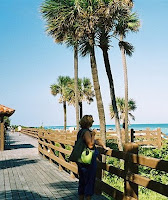 |
| Customs Sign at No Name Harbor |
Register Online
Foreign tourists without a visa who fly into US airports such as Miami International Airport or Fort Lauderdale-Hollywood International Airport, need to have registered online under the US government Visa Waiver Program.
Use the Correct Forms
Also it's necessary to have filled in both the I-94W arrival/departure form (not the I-94 form) and a customs declaration, both of which should be provided on the plane.
Illegals Entering on Boats
A smuggler, illegal immigrant or terrorist on a boat who managed to dodge coastguard patrols could walk away from No Name Harbor (that really is its name), catch a bus over the Rickenbacker Causeway, which links the island of Key Biscayne with the City of Miami, and within an hour or so vanish into the crowds in Downtown.
Tourist Detained for Hours
But a law-abiding tourist needs to fill in all the forms correctly before arrival, or could end up being detained for hours as a friend from Spain was – a woman in her fifties coming to spend a week's holiday in Miami Beach.



